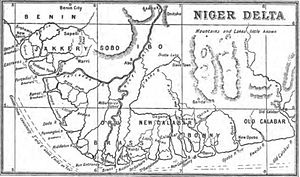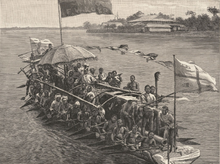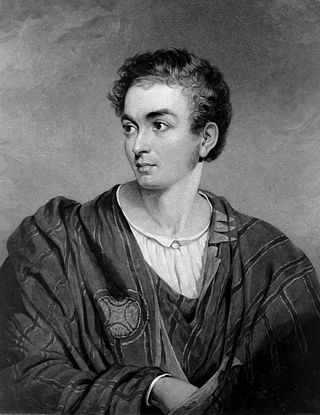
Richard Lemon Lander was a British explorer of western Africa. He and his brother John were the first Europeans to follow the course of the River Niger, and discover that it led to the Atlantic.
This is a survey of the postage stamps and postal history of the Niger Coast Protectorate.
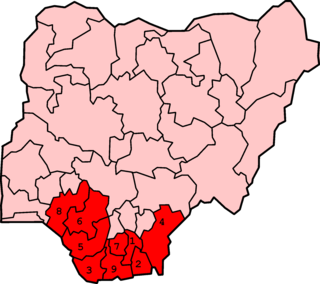
The Niger Delta is the delta of the Niger River sitting directly on the Gulf of Guinea on the Atlantic Ocean in Nigeria. It is located within nine coastal southern Nigerian states, which include: all six states from the South South geopolitical zone, one state (Ondo) from South West geopolitical zone and two states from South East geopolitical zone.

The Nun River is a river in Bayelsa State, Nigeria. The Nun River is formed when the Niger River splits into two at Toru-Abubou, near Agbere Town in Sagbama Local Government Area of Bayelsa State, forming the Nun and the Forcados rivers.

Rivers State, also known as Rivers, is a state in the Niger Delta region of southern Nigeria. Formed in 1967, when it was split from the former Eastern Region, Rivers State borders include: Imo to the north, Abia and Akwa Ibom to the east, and Bayelsa and Delta to the west. The state capital, Port Harcourt, is a metropolis that is considered to be the commercial center of the Nigerian oil industry.
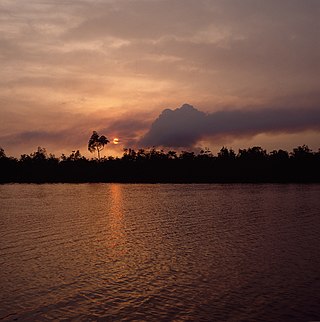
Bayelsa is one of the states in the South-South region of Nigeria, located in the core of the Niger Delta region. Bayelsa State was created in 1996 and was carved out from Rivers State, making it one of the newest states in the federation. Yenagoa is the capital city of Bayelsa State with most parts to have fallen within the high-risk of floods, suspects to occur annually. It shares a boundary with Rivers State to the East and Delta State to the west, with the waters of the Atlantic Ocean dominating its southern borders. It has a total area of 10, 773 km2. The state comprises eight Local Government Areas. they are Ekeremor, Kolokuma/Opokuma, Yenagoa, Nembe, Ogbia, Sagbama, Brass and Southern Ijaw. The state shares borders with Rivers State, of which it was formerly part, and Delta State.

Okrika is an island in Rivers State, Nigeria, capital of the Local Government Area of the same name. The town is situated on an island south of Port Harcourt, making it a suburb of the much larger city.

The Aro Confederacy (1690–1902) was a political union orchestrated by the Aro people, Igbo subgroup, centered in Arochukwu in present-day southeastern Nigeria. Their influence and presence was all over Eastern Nigeria, lower Middle Belt, and parts of present-day Cameroon and Equatorial Guinea during the 18th and 19th centuries. The Arochukwu Kingdom was an economic, political, and an oracular center as it was home of the Ibini Ukpabi oracle, High Priests, the Aro King Eze Aro, and central council (Okpankpo).

Colonial Nigeria was ruled by the British Empire from the mid-nineteenth century until 1960 when Nigeria achieved independence. British influence in the region began with the prohibition of slave trade to British subjects in 1807. Britain annexed Lagos in 1861 and established the Oil River Protectorate in 1884. British influence in the Niger area increased gradually over the 19th century, but Britain did not effectively occupy the area until 1885. Other European powers acknowledged Britain's dominance over the area in the 1885 Berlin Conference.
Brass is a Local Government Area in Bayelsa State, southern Nigeria. Its headquarters are in the town of Twon-Brass on Brass Island along the coast, it has a coastline of approximately 90 km on the Bight of Bonny. Much of the area of the LGA is occupied by the Edumanom National Forest.
Nembe is a Local Government Area of Bayelsa State, Nigeria. Its headquarters are in the town of Nembe in the east of the area at 4°32′22″N6°24′01″E The people of Brass, Nembe and Southern Ijaw Councils of Bayelsa State have bemoaned their neglect by oil companies operating in their areas.
Twon-Brass, previously known simply as Brass or Brasstown, is a community on Brass Island in the Nun River estuary of Southern Bayelsa State, Nigeria, in the Brass Local Government Area. The royal Chief is Alfred Diete-Spiff. The town is on the east shore of the Brass River, one of the branches of the Nun River, which in turn is a branch of the Niger River.

The Nembe Kingdom is a traditional state in Niger Delta. It includes the Nembe and Brass Local Government Areas of Bayelsa State, Nigeria. The traditional rulers take the title "Amanyanabo". Today, leadership is split between the Amanyanabos of Ogbolomabiri, Bassambiri, Okpoama, Odioama and Twon Brass.

The Edumanom Forest Reserve is an area in the Niger Delta region of South East Nigeria, that is home to some of the last chimpanzees in Nigeria. It covers part of the old Nembe Kingdom, which is now divided into the Nembe and Brass local government areas, in Bayelsa State.
The Kingdom of Bonny, otherwise known as Grand Bonny, is a traditional state based on the town of Bonny in Rivers State, Nigeria. In the pre-colonial period, it was an important slave trading port, later trading palm oil products. During the 19th century the British became increasingly involved in the internal affairs of the kingdom, in 1886 assuming control under a protectorate treaty. Today the King of Bonny has a largely ceremonial role.

The Kalabari Kingdom, also called Elem Kalabari, is the independent traditional state of the Kalabari people, an Ijaw ethnic group, in the Niger River Delta. It is recognized as a traditional state in what is now Rivers State, Nigeria.

Lagos Colony was a British colonial possession centred on the port of Lagos in what is now southern Nigeria. Lagos was annexed on 6 August 1861 under the threat of force by Commander Beddingfield of HMS Prometheus who was accompanied by the Acting British Consul, William McCoskry. Oba Dosunmu of Lagos resisted the cession for 11 days while facing the threat of violence on Lagos and its people, but capitulated and signed the Lagos Treaty of Cession. Lagos was declared a colony on 5 March 1862. By 1872, Lagos was a cosmopolitan trading center with a population over 60,000. In the aftermath of prolonged wars between the mainland Yoruba states, the colony established a protectorate over most of Yorubaland between 1890 and 1897. The protectorate was incorporated into the new Southern Nigeria Protectorate in February 1906, and Lagos became the capital of the Protectorate of Nigeria in January 1914. Since then, Lagos has grown to become the largest city in West Africa, with an estimated metropolitan population of over 9,000,000 as of 2011.

King Frederick William Koko, Mingi VIII of Nembe (1853–1898), known as King Koko and King William Koko, was an African ruler of the Nembe Kingdom in the Niger Delta, now part of southern Nigeria.
Nembe Creek Trunk Line (NCTL) is a 97 kilometre, 150,000 barrels of oil per day pipeline constructed by Royal Dutch Shell plc and situated in the Niger Delta region of Nigeria. "The Trunk Line is one of Nigeria's major oil transportation arteries that evacuate crude from the Niger Delta to the Atlantic coast for export." It is owned by Aiteo Group, which recently purchased it as part of the related facilities of the prolific oil bloc OML29 from Shell Petroleum Development Company, SPDC. By March 2015, the Shell Petroleum Development Company of Nigeria Limited (SPDC), a subsidiary of Royal Dutch Shell plc (Shell), completed the assignment of its interest in OML29 and the Nembe Creek Trunk Line to Aiteo Eastern E&P Company Limited, a subsidiary of Aiteo Group. The other joint venture partners, Total E&P Nigeria Limited and Nigerian Agip Oil Company Limited also assigned their interests of 10% and 5% respectively in the lease, ultimately giving Aiteo Eastern E&P Company Limited a 45% interest in OML29 and the Nembe Creek Trunk Line.
The Niger Delta Avengers (NDA) is a militant group in the Niger Delta region of Nigeria. The group publicly announced their existence in March 2016.

